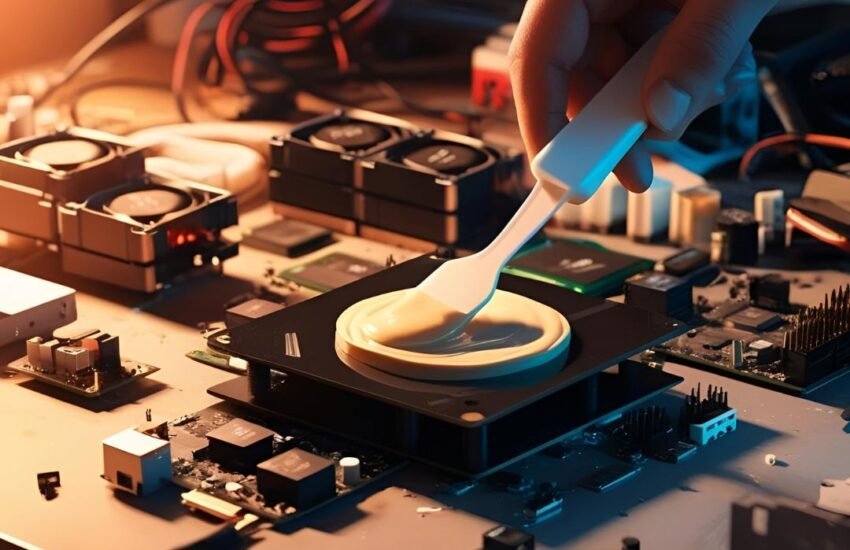A Beginner’s Guide to Thermal Paste
From the Desk of Dr. Naval Kishore Tripathi
Founder – Electo Thermal Solutions
Understanding the Role of Heat Sink Compound
Thermal management is one of the most overlooked yet critical aspects in electronics design. Behind every high-performance CPU, LED module, or power device, there’s a simple, often invisible player doing the heavy lifting—the heat sink compound, commonly referred to as thermal paste.
This material ensures effective transfer of heat from the electronic component to the heat sink by eliminating microscopic air gaps. Without it, even the best-designed cooling systems can underperform due to thermal resistance at the interface.
How It Works
Contrary to common assumption, metal surfaces are never perfectly flat. Even polished ones have microscopic valleys and peaks. When a heat sink is mounted directly on a component, these imperfections trap air—an insulator—leading to thermal bottlenecks.
A heat sink compound is formulated to:
- Fill these micro-voids,
- Create a consistent thermal bridge, and
- Enhance overall heat transfer efficiency.
The compound’s job is not to replace the heat sink but to support it by reducing the thermal interface resistance. The effectiveness of this interface depends heavily on the thermal conductivity (TC) of the paste, its consistency, stability under thermal cycling, and compatibility with the application environment.
Categories of Thermal Pastes
Over the years, several types of heat sink compounds have emerged, each tailored for specific applications. Let’s classify them by base and performance:
| Type | Base | Common Use | Thermal Conductivity Range |
| Silicone-based | Silicone oils with oxides | General electronics, consumer devices | 0.6 to 5 W/m·K |
| Non-silicone | Synthetic oils or esters | High-temp or silicon-restricted systems | 1 to 10 W/m·K |
| Graphite-enhanced | Graphitic composites | Extreme heat scenarios, industrial | 20 to 250 W/m·K (specialized) |
The Electo 2610 Series: Versatility Engineered
At Electo, we’ve engineered a full-spectrum line of thermal interface materials under the Electo 2610 series—formulated to serve a wide range of industries, from lighting and solar to automotive electronics and telecom.
- Thermal Conductivity Range: From 1 W/m·K to 16 W/m·K in our silicone-based variants
- Custom Options: Non-silicone variants available for specialized applications
- High-Performance Line: Advanced graphite-based heat sink compounds with TC values reaching up to 250 W/m·K
These products are developed and manufactured in India, with rigorous quality standards and field-tested performance across industry leaders. We cater to both OEM bulk needs and retail packaging from 5g syringes to 1 kg jars.
Our high-TC graphite variants have found application in steam heating interfaces, battery packs, high-voltage converters, and LED modules, where conventional pastes fall short.
Selecting the Right Thermal Compound
Whether you are a design engineer or a maintenance technician, selecting the correct thermal paste is not just a box-checking task—it affects the long-term reliability of your system.
Here are a few parameters to consider:
- Thermal Load: For CPUs and general-use ICs, 1–4 W/m·K suffices. For power electronics, go for ≥8 W/m·K.
- Material Compatibility: Non-silicone pastes are preferred in applications sensitive to silicone outgassing or insulation failure.
- Electrical Properties: For safety, especially in open boards, ensure the compound is electrically insulating.
- Mechanical Stress: Choose a compound with good pump-out resistance in high-vibration or high-cycle environments.
Application Guidelines
Even the best thermal compound can fail if applied improperly. Key tips:
- Surface Prep: Clean both surfaces thoroughly with isopropyl alcohol.
- Right Quantity: Avoid over-application. A thin, uniform layer is enough.
- Mounting Pressure: Ensure even distribution by securing the heat sink without tilting or shifting.
- Reapply Periodically: Depending on thermal load, paste condition should be reassessed every 18–24 months.
Final Thoughts
Thermal paste may look like an unassuming grey or white smear, but it plays a critical role in safeguarding your electronics from thermal fatigue. As performance demands rise and device footprints shrink, thermal interface materials are no longer optional—they are essential.
At Electo, our R&D continues to evolve. With the Electo 2610 range, we offer trusted performance across industries, including custom-developed pastes with ultra-high conductivity (up to 250 W/m·K) for next-generation cooling challenges.
For technical data sheets, samples, or customized formulations, feel free to reach out via www.electo.co.in or connect directly with our application engineers.
Warm regards,
Dr. Naval Kishore Tripathi
Director, Electo Thermal Solutions
28+ years in Electronics & Thermal Management

